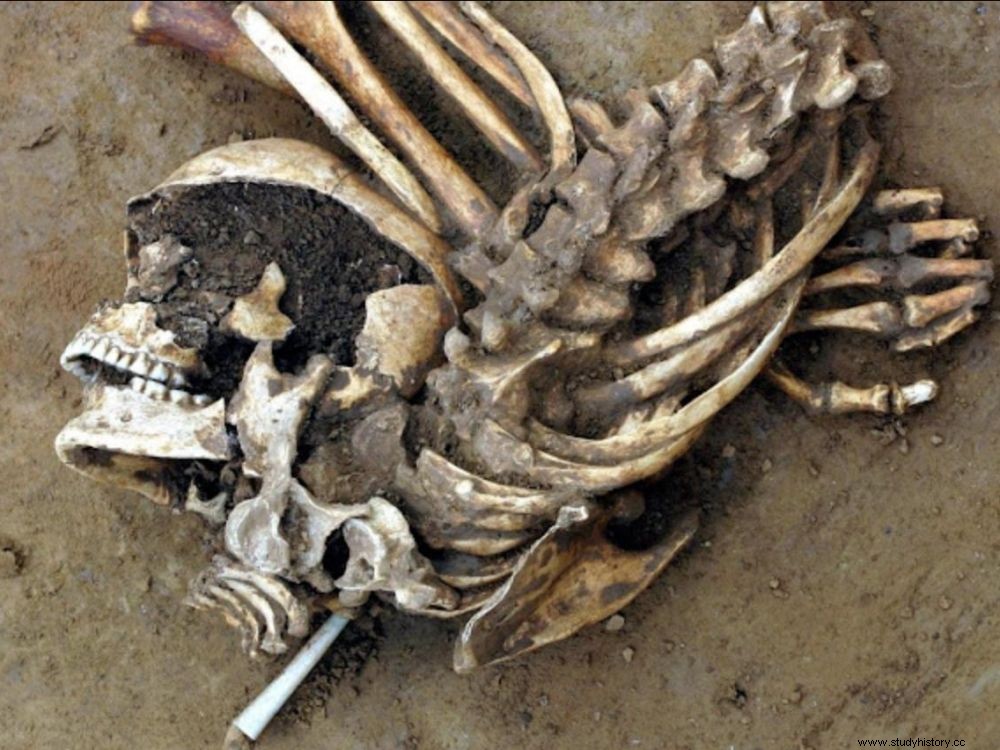An extensive genomic analysis has revealed the existence in Great Britain of an unknown migratory wave that came from France during the Bronze Age.

A ribcage like wings... This Bronze Age individual unearthed at the archaeological site of Cliffs End Farm, in Kent, could have been part of the important migration to Great Britain revealed by recent genetic analyses.
Announced as the most important genomic analysis ever conducted to date, the results of a new study of ancient DNA have just been unveiled. They reveal a significant human migration between what is now France and southern Britain (England and Wales) during the Late Bronze Age between 1000 and 875 BC. J.C. Enough to allow the very distinguished American daily newspaper New York Times to headline December 22, 2021 with humor - or perfidy -:"3000 years ago, Great Britain got half of its genes from... France" .
223 international researchers mobilized
Published in the rigorous journal Nature , this scientific analysis was led by paleogeneticist David Reich, professor in the Department of Human Evolutionary Biology at Harvard Medical School (USA). It brought together 223 international researchers. Previously, concerning the Neolithic periods, only two major migrations had been highlighted. One about 6000 years ago, made up of early farmers or Early European Farmers (EEF), whose ancestors lived in Anatolia (now Turkey) and which would have led to the replacement of most of the local hunter-gatherer populations; the second 4500 years ago, at the beginning of the Bronze Age, where newcomers associated with the Beaker Culture (Bell Beaker) would have in a few centuries replaced nearly 90% of the genetic heritage of the island.
It is therefore a third migratory wave 3000 years ago -probably from France- that has just been highlighted by the recent genomic study carried out from the extraction of ancient DNA from bones and teeth of 793 human remains. unearthed during archaeological excavations. For David Reich and his team, these latest arrivals would even have replaced, by mixing with the local populations encountered, up to 50% of the genetic ancestry of the inhabitants of the south of the island in the Middle and Final Bronze Age ( between 1400 and 875 BC) and the beginning of the Iron Age.
We better understand the spread of the first Celtic languages on the island
While archaeologists already knew of the existence of trade and crossings from the mainland for these periods, "the new DNA evidence shows that many more people than previously thought moved to these long distance s", commented Ian Armit, archaeologist from the University of York (England) involved in the study. These findings would also open new perspectives on another enigma. The arrival and spread of the first Celtic languages on the They would support a recent theory supported by David Reich, according to which, in the Middle and Late Bronze Age, the first Celtic languages would have been introduced into Great Britain from France during these migratory movements. sooner than we thought. A question nevertheless still debated.

Burials of four Bronze Age individuals unearthed at the Cliffs End Farm archaeological site in Kent. © Wessex Archaeology
"These new data only confirm the close links and intensive exchanges already identified by archeology between southern Britain and France during the Late Bronze Age, particularly in the region of Kent", declared Cyril Marcigny, of the National Institute for Preventive Archaeological Research (Inrap). More interestingly, the analysis of bodies discovered on the site of Cliff End Farm, in Kent, where violence between individuals has been identified, can open up other hypotheses such as brutality between migrants and natives. Between the Middle Bronze Age and the 1 st Iron Age, we know on the coast of the Channel, in France and in Great Britain the same cultural baggage grouped under the term of the cultures of Manche-Mer-du-Nord (MMN), with types of ceramics, constructions and identical boats as well as similarities in the use of agricultural spaces.
"However, these genomic analyzes would benefit from being amplified. There are indeed very few 3000-year-old graves on either side of the Channel, and the human remains sampled in the published study belong mostly to elite characters , and are therefore not truly representative of all populations" , says the Inrap archaeologist who answered questions from Sciences et Avenir. For David Reich, on the other hand, one thing is certain:"Advances in large-scale paleogenomics, combined with data from archeology, open new perspectives on the knowledge of ancient populations" . This puzzle of human migrations whose gaps all paleogeneticists dream of filling.
